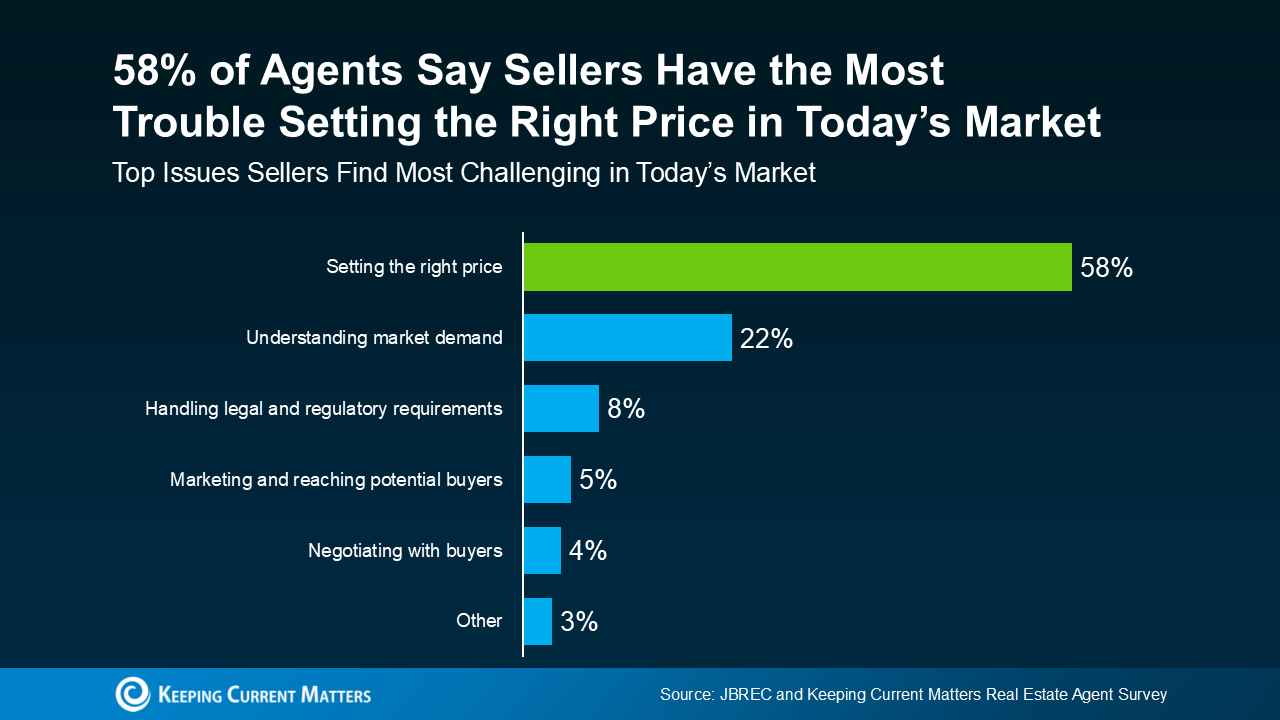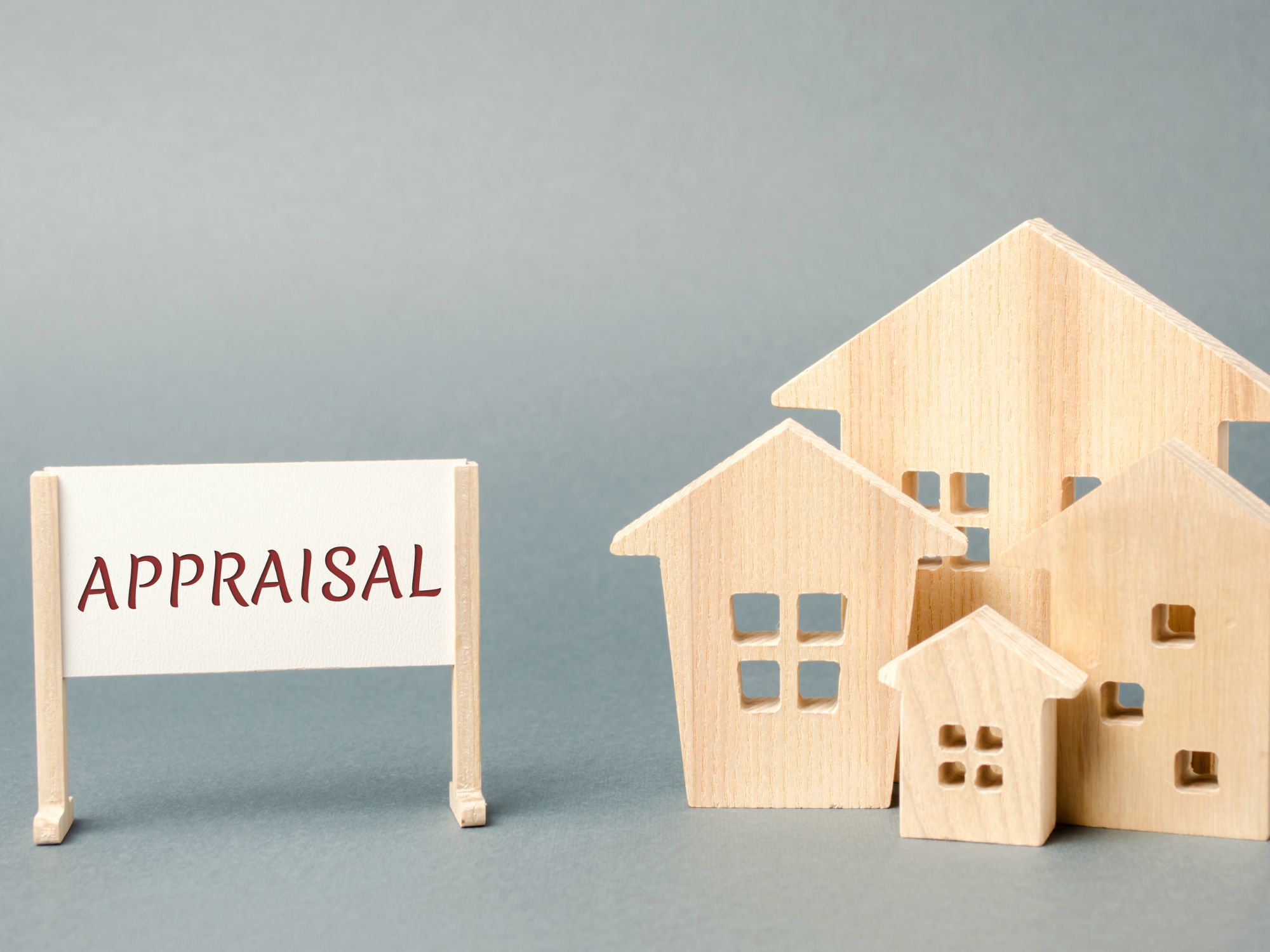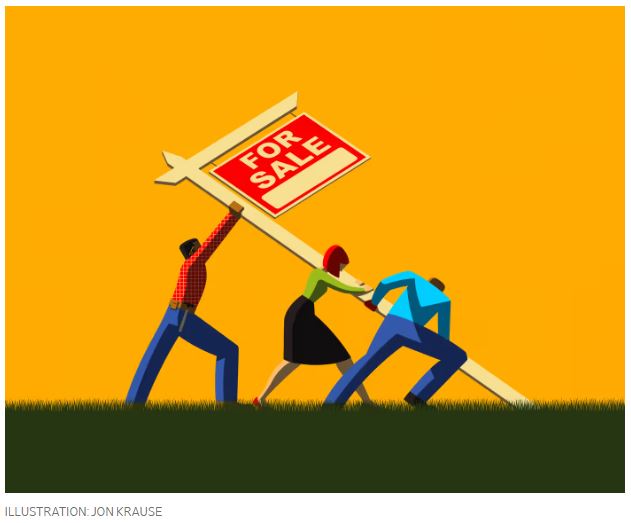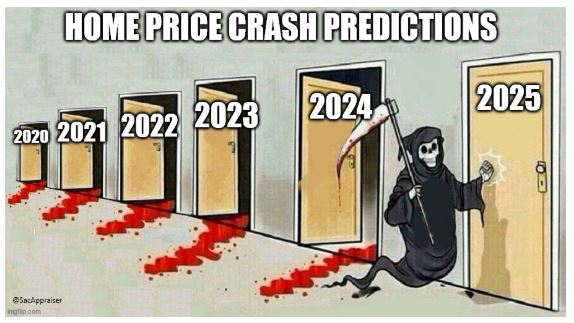The 3 Biggest Mistakes Sellers Are Making Right Now

If you want to sell your house, having the right strategies and expectations is key. But some sellers haven’t adjusted to where the market is today. They’re not factoring in that there are more homes for sale or that buyers are being more selective with their budgets. And those sellers are making some costly mistakes.
Here’s a quick rundown of the 3 most common missteps sellers are making, and how partnering with an expert agent can help you avoid every single one of them.
1. Pricing the Home Too High
According to a survey by John Burns Real Estate Consulting (JBREC) and Keeping Current Matters (KCM), real estate agents agree the #1 thing sellers struggle with right now is setting the right price for their house (see graph below):
 And more often than not, homeowners tend to overprice their listings. If you aren’t up to speed on what’s happening in your local market, you may give in to the temptation to price high so you can have as much wiggle room as possible to negotiate. You don’t want to do this.
And more often than not, homeowners tend to overprice their listings. If you aren’t up to speed on what’s happening in your local market, you may give in to the temptation to price high so you can have as much wiggle room as possible to negotiate. You don’t want to do this.
Today’s buyers are more cautious due to higher rates and tight budgets, and a price that feels out of reach will scare them off. And if no one’s looking at your house, how’s it going to sell? This is exactly why more sellers are having to do price cuts.
To avoid this headache, trust your agent’s expertise from day 1. A great agent will be able to tell you what your neighbor’s house just sold for and how that impacts the value of your home.
2. Skipping Repairs
Another common mistake is trying to avoid doing work on your house. That leaky faucet or squeaky door might not bother you, but to buyers, small maintenance issues can be red flags. They may assume those little flaws are signs of bigger problems — and it could cost you when offers come in lower or buyers ask for concessions. As Investopedia says:
“Sellers who do not clean and stage their homes throw money down the drain. . . Failing to do these things can reduce your sales price and may also prevent you from getting a sale at all. If you haven’t attended to minor issues, such as a broken doorknob or dripping faucet, a potential buyer may wonder whether the house has larger, costlier issues that haven’t been addressed either.”
The solution? Work with your agent to prioritize anything you’ll need to tackle before the photographer comes in. These minor upgrades can pay off big when it’s time to sell.
3. Refusing To Negotiate
Buyers today are feeling the pinch of high home prices and mortgage rates. With affordability that tight, they may come in with an offer that’s lower than you want to see. Don’t take it personally. Instead, focus on the end goal: selling your house. Your agent can help you negotiate confidently without letting emotions cloud your judgment.
At the same time, with more homes on the market, buyers have options — and with that comes more negotiating power. They may ask for repairs, closing cost assistance, or other concessions. Be prepared to have these conversations. Again, lean on your agent to guide you. Sometimes a small compromise can seal the deal without derailing your bottom line. As U.S. News Real Estate explains:
“If you’ve received an offer for your house that isn’t quite what you’d hoped it would be, expect to negotiate . . . the only way to come to a successful deal is to make sure the buyer also feels like he or she benefits . . . consider offering to cover some of the buyer’s closing costs or agree to a credit for a minor repair the inspector found.”
The Biggest Mistake of All? Not Using a Real Estate Agent
Notice anything? For each of these mistakes, partnering with an agent helps prevent them from happening in the first place. That makes trying to sell your house without an agent’s help the biggest mistake of all.
Bottom Line
Avoid these common mistakes by starting with the right plan — and the right agent. Connect with an agent so you don’t fall into any of these traps.
How Home Sellers Can Use Concessions to Get to Closing

As home inventory begins to grow and buyers regain some advantage in the market, sellers may consider offering more in negotiations to make the deal more attractive and get to the closing table.
“With where interest rates are, buyers can be deterred if they don’t feel like they’re getting some kind of deal,” says Cooper Thayer, ABR, broker-associate at Keller Williams Action Realty in Denver. “We’re definitely advising sellers that they can expect to offer a concession to help a buyer get into their home specifically—if it’s not a super-hot product.”
What Are Seller Concessions?
A concession is when the seller covers certain costs associated with the purchase of the home. Concessions can make homeownership more accessible for buyers by reducing upfront costs. Seller concessions are often used in markets where buyers have more negotiating power or when the seller needs to stand out in a competitive environment.
Real Examples of Seller Concessions in Action
NAR data found that “given buyer demand and lack of housing inventory,” only 24% of sellers nationwide offered a concession in 2024, down from 33% the previous year.
While the 2025 housing market remains to be seen, several signs point to a healthier outlook: both pending home sales and existing-home sales jumped in November and there are more homes on the market compared to a year ago.
“Sellers do have to differentiate themselves in the market now with the levels of inventory that we’re at,” Thayer says.
In late 2024, NAR published a one-page resource on seller concessions, which is part of a series of Consumer Guides that NAR provides at facts.realtor. The consumer guides address many aspects of the homebuying and selling process as well as the real estate practice changes that went into effect last August. NAR members can share the guides directly with their clients.
Concessions can cover a wide range of costs, like those associated with a title search, home repairs or fees for real estate agents and appraisers. Closing costs were the most common concession in 2024, NAR data shows. That makes sense in markets with a high volume of first-time buyers, like Salt Lake City, where the median age of residents is 33.
“First-time home buyers are huge in our area,” Scott Robins, an associate broker at Summit Sotheby’s International Realty in Salt Lake City, says. “We have two universities in downtown Salt Lake City. We have four additional universities within an hour drive. If I’m working with a first-time home buyer, it’s almost given that they are going to need some help with concessions.”
He says those in their late-20s and early-30s “typically have their down payment, but they don’t have all of their closing costs.”
Robbins says 2-1 buydowns as a seller concession are popular. Essentially, the seller will pay to reduce the buyer’s mortgage rate by two percentage points for the first year and one percentage point for the second year. After those two years of monthly savings, buyers are on the hook for their agreed upon mortgage rate.
“The place where concessions or rate buydown offerings are really being successful right now is with new construction,” Thayer says. “We’re seeing builders utilize those kinds of incentives a lot more because they have the ability to, one, hold on to their inventory longer, and two, do a better job at marketing those incentives. They’ve got a little bit more marketing purchase power than the average [real estate broker or agent] has.”
Home repair credits are also common. Most buyers want a turnkey home, Thayer says, “so those concessions are a useful tool, but they’re definitely not the end-all, be-all.”
Marlene Llamas Leon, ABR, CIPS, of LPT Realty in Miami recalls a recent deal on a large estate in which her sellers chose to make a concession.
“What came up in the inspection were six roof leaks that [the sellers] had no idea they had, and the new roof for the home was $120,000,” she says. “So, that was definitely something that [if this transaction had fallen through] we would have had to disclose, and it would have been a turnoff for any buyer that would have walked in next. These sellers were very proactive, thank goodness. Once I spoke to them, they completely understood, and they said, ‘Please leave it up to the buyer. Do they prefer a credit or a price reduction?’”
The buyer went with a price reduction.
In general, Thayer advises his sellers to make repairs before putting their homes on the market.
“That is really the best strategy that we’ve seen … to really differentiate your home as much as possible so we don’t have to start talking about concessions and really minimize what may come up in an inspection objection,” Thayer says.
Stage Your Home for a Quick Sale

Home staging is a strategic way of preparing your home to spotlight all of its best features while downplaying its shortcomings. This includes decluttering, depersonalizing and making any necessary repairs or improvements to the house. Home staging is not required, but it can make a difference in a tight, competitive selling market.
Staged homes tend to sell faster than those that are not staged. According to the Real Estate Staging Association, staged homes recently sold for about $40,000 above asking price. Staged homes were reported to sell nine days faster than the average home.
While you can work with a professional stager, know going in that you will spend somewhere between $782 and $2,817 for this service. If your home is in good shape and only needs some decluttering and rearranging of furniture, then the fee could be as low as $800. If you have already moved out of your home and your home is empty, you will need to rent furniture to furnish some of the important rooms. This is a necessary cost for selling your home.
somewhere between $782 and $2,817 for this service. If your home is in good shape and only needs some decluttering and rearranging of furniture, then the fee could be as low as $800. If you have already moved out of your home and your home is empty, you will need to rent furniture to furnish some of the important rooms. This is a necessary cost for selling your home.
If you would rather stage your home yourself, here are some key tips to help you through the process.
- First, try to see your home through the eyes of a prospective buyer. The buyer wants to see a home that is neat and tidy. To that end, you will need to declutter your home to make it look as spacious and airy as possible. An added benefit of taking this step is that it helps you discard some of your possessions as you eventually prepare to pack for your move. This is especially important when you are downsizing to a smaller home. Think about what is essential. Do you really need your children’s drawings to be prominently displayed on your refrigerator door when buyers are looking?
- You want the home to be as impersonal as possible so the buyer can imagine themselves and their furnishings in the space. Depersonalizing the home is one way to achieve this. No one wants to feel like they are intruding into someone else’s home. Seeing someone else’s family photos might be a distraction. Remove family photos and replace them with more neutral items such as plants or vases.
- After you have decluttered, you will need to deep clean the house. Again, you can call in professionals who can clean your home within hours or you can do it yourself over the course of days. Replace anything that needs to be freshened up such as towels, area rugs or plants. A clean home will have greater appeal to buyers.
- Next, take a look to see how the furniture is arranged. Does the seating invite conversation among guests or is it spaced too far away? Pull the seats close to the center of the living room so they are facing each other. Place a simple well-decorated coffee table in the middle of the arrangement. A few candlesticks, a short stack of art books or a glass vase are all that are needed.
A staged home conveys a message of pride of ownership to any potential buyer. Staging also improves the chances of a quick and profitable sale. Contact us for more staging ideas when you are ready to sell your home.
Credit Scores: Don’t Sweat the Small Stuff

Will opening a new store credit card hurt your three-digit FICO credit score? Will closing that credit card account that you haven’t used in 10 years cause your score to drop? Will applying for a home equity loan cause your score to tumble? You may not need to be as worried as you are! Learn how credit scores work.
Why your credit score matters
Lenders study your three-digit FICO credit score whenever you apply for a new credit card or loan. The higher your score, the more likely you are to qualify for a mortgage, an auto loan or a credit card with a lower interest rate. If your score is too low, you might struggle to qualify for new credit or loans at all.
Most lenders consider FICO scores of 740 or higher to be very good and those of 800 or higher to be excellent. If your score is in those ranges, you’ll likely qualify for loans and credit with lower interest rates.
But how do you build a score in those ranges?
What makes up your credit score
FICO says that your credit score is made up of several factors, including your record of on-time payments, the amount of available credit you are using, the age of your credit accounts, the diversity of your credit accounts and your new credit.
This means that whenever you take out a new credit card or close an existing account, your credit score can take a small hit. This hit makes many people nervous; they worry that every financial move they make will have a negative impact on their credit score.
The truth is that while such decisions as applying for a new personal loan will impact your credit score, there are two factors that have an outsize influence on your score: your record of on-time payments and the amount of available credit you are using.
These two factors account for 35% and 30% of your credit score, respectively, or 65% combined.
This means that if you pay the bills that are reported to the three national credit bureaus on time each month — bills including your mortgage, student, auto and personal loan payments and your minimum monthly credit card payment — your credit score will steadily rise.
It also means that if you pay down as much of your credit card and other debts as you can, your score will tick upward.
Yes, other factors do matter. But paying your bills on time each month and reducing your credit card debt are the two steps that will most boost your credit score. If you take these steps, you won’t have to fret quite as much about your smaller financial decisions and their impact on your credit score.
Consumer Guide: The Appraisal Process

If you are financing your home purchase, you will likely be required to get a home appraisal as one of the steps between signing and close. Here’s what you should know:
What is an appraisal?
An appraisal is an opinion on a home’s market value that helps a lender ensure the purchase price is in line with the property value. The process is led by a licensed or certified residential appraiser—an independent third party engaged by the lender to provide a professional judgment on the home’s value. Appraisers do not represent the buyer or seller; their sole duty is to come up with a fair and accurate valuation of the property. While all appraisers follow a set of standards, appraisers who are REALTORS® have the added commitment to uphold the REALTOR® Code of Ethics.
Do I have to get an appraisal?
If you are taking out a mortgage on your new home, your lender will usually require you to get an appraisal to help establish the “loan-to-value (“LTV”) ratio,” or the percentage of the home's price that you'll borrow. Higher LTV ratios are riskier investments for the lender, so generally they look for LTV ratios of 80% or less. If you are paying in cash, an appraisal isn’t required, but it can still be useful to get a third-party opinion to make sure you aren’t overpaying. In certain instances, the requirement for an appraisal may even be waived by either the lender or the buyer to make their offer more attractive to a seller.
What does an appraiser look at?
Different appraisers may take different approaches. By referencing databases such as Multiple Listing Services—online platforms that compile home listings in a given market—appraisers can use recently sold properties that have similar characteristics, called “comparables,” to help come up with a reasonable value for your home. They will also look at the home’s condition, recent renovations or improvements, amenities, location, size, and other characteristics. Whatever method an appraiser uses, it must be independent, un-biased, and backed up by evidence.
Do appraisals take place in person?
An appraisal may include an in-person visit, but it is not always required. In some instances, hybrid and desktop appraisals are used where appraisers collect data remotely and speak with reliable third-party sources familiar with the property and surrounding area, such as current or former agents of the comparables being considered.
Is my agent allowed to communicate with the appraiser?
Yes. Your agents and others involved in the transaction are allowed to communicate with the appraiser and provide property information. It is not only unethical, but it is also unlawful for agents to intimidate, persuade, or bribe an appraiser to influence the valuation, and an appraiser may not disclose confidential information at any time.
What happens if the appraised value is different from the purchase price?
A mismatch between a home’s appraised value and the purchase price can impact how much your lender allows you to borrow for your mortgage. You can negotiate to include an appraisal contingency—a condition that the value and purchase price must align in order for the transaction to continue—in your purchase agreement, but an appraisal contingency is not required.
Will I receive a copy of the appraisal?
Yes. The Federal Equal Credit Opportunity Act requires lenders to automatically send you a free copy of home appraisals and all other written valuations on the property after they are completed. However, if you are granted an appraisal waiver by your lender, your lender is not required to send you a copy of the valuation report.
Can I request that an appraiser correct or update the appraisal?
If you believe the appraiser did not consider important information about the property or available comparables, you can request a reconsideration of value (“ROV”) to ask that the appraiser reevaluate their analysis. Your lender will provide instructions on how to initiate an ROV, and your agent can help you gather the appropriate information to complete the request. If you believe an appraiser has reached an inaccurate or biased decision, you can also file a report with your state and federal regulatory agencies using the Appraisal Subcommittee’s Appraisal Complaint National Hotline, or a local nonprofit fair housing organization (find by ZIP code here). Find support and other resources here.
Real Estate After Death

When you die, do you want to create chaos and negativity as you pass away? If so, then make sure to do almost zero estate planning! No matter your level of wealth, if you don’t do any planning of your estate, you could easily leave your children or relatives with very few assets, and the assets you do leave may incur massive expenses for those who receive them. Additionally, you may create serious arguments among your heirs. For example, if your children do not get along and end up as co-owners of your house, they must still agree on how, if, and when to sell your property, and this can create bitter, relationship-ending disputes. If intense, posthumous disputes are the legacy you’d like to leave behind, then a severe lack of estate planning is a great way to achieve your goals.
If you’re already exhausted thinking about estate planning, relax; this is work that you should mostly leave to professionals. Find a good estate planner, and have them advise you on the best way to arrange your estate based on your individual situation and goals. One helpful resource is the non-profit National Association of Estate Planners and Councils. Also, if you have a retirement account through your work, you can often get some help from a financial adviser.

Though you should always discuss estate planning with a professional, there are a few larger concepts that are helpful to at least partially understand so you can be prepared to get the most out of discussions with your estate planner. One important consideration is that there is no single best way to transfer your estate. The best way for you to transfer your assets depends on the size of your estate, the types of assets you own, and the state in which you live. For example, if you live in Florida, there is no state estate tax. However, even in Florida, you still would owe federal estate taxes, which range from 18% to 40%. This is a significant tax, but it only applies to estates worth more than $13.61 million (this figure changes frequently). This means that only about 8 in 10,000 estates pay federal estate tax at all. If you live in Iowa, however, estates of more than $25,000 owe estate taxes (with certain exceptions). Thus, the state where you live, as well as estate size, has a massive effect on tax burden.
As we’ve discussed using Florida as an example, if you live in one of the 33 states with no estate tax, then you’ll only owe estate taxes if you have an estate worth more than $13.61 million (remember that this number changes often). If you have an estate of this size, you probably stopped reading this article within the first paragraph, because you likely have already been over these issues with a professional, and if you haven’t, stop everything you’re doing and call one right now. For the rest of us in those 33 states, it’s not so much federal estate taxes to be concerned about, it’s things like capital gains taxes and state taxes.
If a piece of real property is a significant part of your estate, the first thing you should do is determine your heirs’ level of interest in this property. If you are passing your house to an heir who cannot afford property taxes and can’t pay for maintenance, they may have to sell the property shortly after receiving it. Selling property in a short time frame means the price may have to be extremely low. If you’re passing on a vacation home to your three children, consider whether they really want to use this vacation home, or if owning this home together will cause financial disputes and other arguments. It’s nice to imagine that they will all use the old family vacation home together in perfect harmony, but let’s be honest, this may be a disaster.

After you’ve had a good, realistic talk with yourself and your heirs about who will best take care of and appreciate your real estate, it may be a good idea to put this real estate into a trust so that the property will immediately pass to your heirs on your death and avoid probate. Putting property into a trust is not an extremely difficult process, though it does require professional help. The basic idea is rather simple–you will no longer own your property as an individual person, but your property will be owned by a trust called something like “(Your Name) Revocable Trust.” Your heirs will be named as the beneficiaries of this trust, so they will essentially replace you in the trust once you pass away. Neither you nor your beneficiaries will own the property, but will be the beneficiaries of a trust that owns the property.
One essential consideration regarding real property and trusts is capital gains tax. When an heir inherits property, they get a potentially massive shield from capital gains tax. This massive tax shield involves a concept called “stepped up basis.” If you bought a property for $100,000 decades ago and sold it for $800,000, you would owe capital gains taxes on $700,000 worth of gain. Your original basis in the property is $100,000, and you are not taxed on your original investment (aka your “basis”), which is why you’d be taxed on $700,000 of gain and not on the full sale price of $800,000. However, if you spent $100,000 on a property decades ago that is now worth $800,000, did not ever sell the property, and your heir inherited it, your heir’s basis in the property would be “stepped up” to its current market value of $800,000. Thus, your heir would pay zero capital gains taxes if they sold the property for $800,000. A simpler way of saying this is that capital gains tax liability is essentially erased when property is inherited. Unfortunately, someone has to die to activate this amazing tax break, but I guess everything has a price.
Capital gains tax is also a significant consideration when creating a trust. For example, if you put your real estate into a revocable trust, your heirs will likely get a stepped up basis in your property when they inherit it, so they will likely avoid capital gains taxes. However, if you put your property into an irrevocable trust, your heirs will not avoid capital gains tax. This is because an irrevocable trust does not change in any fundamental way once you die, so death of the grantor (you) is not particularly relevant to an irrevocable trust. However, a revocable trust automatically becomes an irrevocable trust upon your death, and this change in the nature of the trust creates a stepped up basis for your beneficiaries, according to the IRS.
Don’t get me started on Intentionally Defective Grantor Trusts (IDGTs), which function partially as irrevocable trusts, and partly as revocable in the eyes of the IRS. I’ll stop talking about these right now, other than to say that they create a hybrid of tax advantages that can help save your estate money. My point in referencing this somewhat boutique type of trust is to point out that there are a surprising number of options available to suit your specific situation, options that can dramatically change the amount of money you have now, and that your heirs have in the future. A good estate planner will be able to listen to your wishes, and then outline the most cost-saving options to suit your goals. Though I’m not an attorney, I am absolutely certain that assuming your assets will simply sort themselves out after you die is the worst of all the options you’re considering.
I do not expect you to be an expert in estate planning after reading this–I’m not that good of a writer! But I hope that, if you’ve made it this far in this article (and in life) that you have a general, ballpark idea of some of the complex issues to bring up with your estate planner. I also hope you have a new appreciation for how important estate planning is for everyone, no matter how big or small your estate.
I’d also like to backtrack on something I said earlier–you can in fact plan your estate with a skilled professional, and still create absolute chaos when you pass away. If you let your planner know that you’d like to create unbelievable expenses and set up bitter disputes among your heirs, some skillful estate planning could absolutely create a wake of chaos upon your death. The choice is yours!
by | Jul 23, 2024
Your Home Sale and Capital Gains

Let’s start with the basics: What is capital gains tax? It is a type of tax on profits earned from the sale of assets like stock or real estate. When these are sold for more than they cost to purchase, the IRS taxes the gain.
In real estate, capital gains are calculated by taking the final total sale price of the house and deducting its original cost. However, the tax on that gain is calculated with additional considerations:
- How long you owned the house
- Any fees you’ve paid — escrow, recording and appraisal fees, brokers’ commissions
- Your income tax bracket

- Your marital status
If you’ve owned your house for less than a year, then the capital gains are considered short term. In this case, taxes are paid at the same rate you’d pay for ordinary income (such as wages from your job). If you owned your home for more than a year, the capital gains are considered long term. In 2024, the rates for long-term capital gains are 0%, 15% or 20%; which rate you pay depends on your income level. All are typically lower than ordinary income tax rates.
You’ll also pay state taxes on your capital gains unless you live in a state that has no income tax (though New Hampshire, which has no income tax, does tax investment income).
Exclusions
It’s likely that you’ve owned your home for more than a year, so you will probably be subject to long-term capital gains rates. However, you may be able to avoid some of the tax because real estate gains are subject to different rules than investment capital gains. These rules apply only to your primary residence, though; if the home you sold was a second property — an investment, vacation or rental home — and you never converted it to your primary property, you are not eligible for capital gains tax exclusions.
For most of the following exemptions, you will need to have owned and lived in the house for two of the five years preceding the sale:
- You might be able to defer capital gains if, after you sell your property, you apply your profits to the purchase of a new property within 180 days.
- You might be able to take advantage of a capital gains tax exclusion that applies to your primary residence once every two years. Exemptions are $250,000 if single and $500,000 for couples filing jointly. (Some widowed individuals may be eligible for the $500,000 exemption.)
- Itemized construction expenses can be added to the cost basis of your house, thereby helping decrease your tax liability. Improvements must be considered major — adding a new bedroom, renovating a kitchen or bathroom, installing a roof — and must be documented; estimates won’t work. (For examples of other home improvements, see IRS Publication 523, Selling Your Home.)
- Selling costs like real estate agent fees and closing costs can be deducted from the sale proceeds to reduce your capital gain.
- You might qualify for a partial exclusion if you sold your home as the result of an unforeseen circumstance — for example, if you moved for work, had a health complication, faced divorce or marital separation, suffered the death of your spouse or incurred a loss from a natural disaster. You may also qualify for a partial exclusion if you came to serve in the uniformed services, foreign service or intelligence services.
You may be like many homeowners who’ve experienced significant capital gains since you purchased your home, but you can manage the tax liability and keep more of the profit in your pocket. Consult a tax professional to determine all the tax implications of selling your home.
2025 Trend Report




The Trend Report 2025
The Coldwell Banker Global Luxury® program unveils the third installment of The Trend Report, a comprehensive analysis of what’s new and noteworthy for high-net-worth real estate.
This wildly popular and award-winning annual report series draws upon insights and data from leading sources like the Institute for Luxury Home Marketing, Wealth-X, and other industry experts. Together, these sources provide a unique perspective on the evolving landscape of luxury real estate, highlighting the key trends shaping the market today and predicting future directions of luxury property buying and selling.
What's inside The Trend Report 2025:
- Luxury Shows Resilience: Luxury housing continues to outperform the broader market, with single-family home prices growing twice as fast.
- Positive Outlook for 2025: Over 85% of Luxury Property Specialists express optimism for buyers, and 74% for sellers, indicating a positive market outlook for 2025.
- More Property Selection Powers Pent-Up Demand: Increasing inventory is creating more opportunities for buyers, potentially unleashing pent-up demand.
- The Rise of the "She-Elites": Affluent women are a dominant force in luxury real estate, driving demand and influencing purchasing decisions.
- Doors Open for Gen X, “The Luxury Latchkey Generation”: Gen X buyers are a key growth segment, fueling demand for multi-generational living spaces.
- Indoor-Outdoor Living Remains Paramount: Over 60% of Luxury Property Specialists rank indoor/outdoor living as a top feature among their clients, reflecting a growing demand for seamless indoor-outdoor spaces.
- Value-Driven Luxury: Affluent buyers are increasingly focused on value, seeking properties that offer unique experiences and long-term returns.
- New Luxury Location Drivers: Wealthy individuals are seeking new locations that offer lower taxes, economic opportunity, safety, lifestyle benefits, and favorable climates.
- Developers Adapt to Evolving Demands: Luxury developers are creating bespoke projects that cater to the evolving needs and preferences of today's discerning buyers.
Small Fixes Can Pay Off When You Sell Your Home
SMALL FIXES CAN PAY OFF WHEN YOU SELL YOUR HOME
You want to sell your home, but the kids have scuffed up the floors and chipped the paint. The kitchen could use a face-lift and the lawn has seen better days.
Every seller has to decide whether to sink money into their house before listing it, and how much. Lately, the stakes have grown as the cost of construction and materials has skyrocketed. Borrowing to pay for those repairs has gotten more expensive, too.
The consensus among the dozen real-estate agents interviewed by The Wall Street Journal: Don’t go overboard.
Shelling out small sums to punch up highly-visible parts of the property, particularly outside, increases the curb appeal. Spending large amounts to turn the place into your dream home doesn’t make it someone else’s dream home. (Below is a bang-for-your buck guide.)
“Sellers should avoid trying to become a general contractor,” said Scott Harris, a real-estate agent at Brown Harris Stevens in New York.

What to fix
Replacing a garage door cost $4,513 on average in 2024, but added $8,751 to the resale value, recouping 194% of the cost, according to Zonda, a residential construction-focused research company. That project provided the most value in the firm’s annual cost-value comparison.
Replacing an entry door cost $2,355 on average and added $4,430 to resale value, recouping 188% of the cost.
“They will recoup all of that with very low risk, and it’s a low outlay,” says Todd Tomalak, principal at Zonda, about exterior doors.
Minor exterior work is some of the most likely to pay off. It makes the house look nicer in listing photos and brings potential buyers through the door, real-estate agents say.
A National Association of Realtors survey from 2023 found that sellers would recoup 217% of the cost of lawn care, 104% of the cost of landscape maintenance, and 100% of the cost of overall landscape upgrades.
Small-ticket items inside the house are worthwhile, too. Refinishing hardwood floors on a roughly 2,500 square foot home costs an estimated $3,400, but adds roughly $5,000 to the value of the house, according to a 2022 NAR survey.
What to skip
There is a high bar for doing costly work, like remodeling a kitchen or adding a new bathroom. Your tastes aren’t guaranteed to appeal to potential buyers, meaning they won’t necessarily be willing to pay lots more.
“Unless you have objectively excellent taste or can remove your personal preferences from the process and focus only on timeless, enduring style, I do not advise sellers to invest in a major renovation,” said Kate Wollman-Mahan, a real-estate agent at Coldwell Banker Warburg in New York.
Adding an upscale primary suite to a house costs $339,513 on average, but only adds $81,042 to the resale value, recouping 24% of the cost, according to Zonda. Remodeling an upscale kitchen costs $158,530 on average, but adds $60,176 to the resale value, recovering 38% of the cost.
Instead, think smaller. Refresh an old room with new cabinet pulls or more modern light fixtures. Reglaze a bathtub. Replace old toilet seats and shower rods.
Jennifer Roberts, a real-estate broker at Coldwell Banker Warburg in New York, said she once had trouble selling an apartment with red kitchen cabinets. After she had the seller paint them white, the home went quickly.
It is also tough to make the math work on major exterior projects. A metal roof replacement costs $49,928 on average, but adds $24,034 to the resale value, recovering 48% of the cost, according to Zonda.
Low-cost, big payoff
Painting the walls and pulling up old carpets can freshen the house, even if the finishes are dated. Decluttering the spaces, washing windows and treating lingering smells all help the house to show better.
“I watched a home priced under a million languish on the market with another agent,” said Benjamin Dixon, a real-estate broker at Douglas Elliman in New York. “We came in and decluttered, painted, cleaned and staged, investing a total of under $20,000 and had multiple offers and sold the home for $1,050,000 in just a few weeks.”
By Veronica Dagher and Ben Eisen
ET


 Facebook
Facebook
 X
X
 Pinterest
Pinterest
 Copy Link
Copy Link


